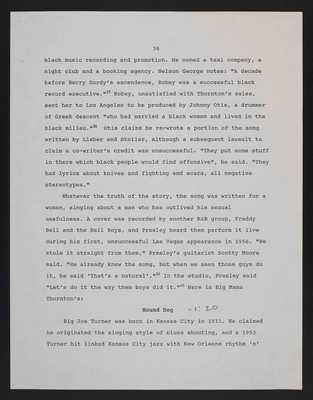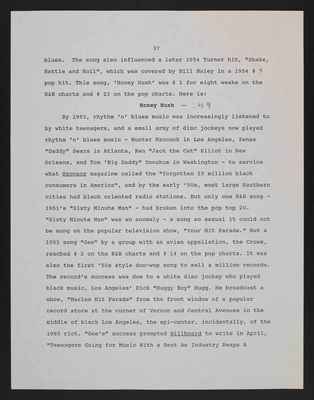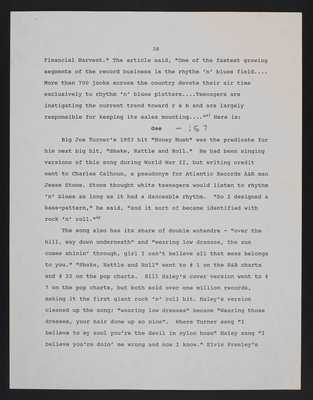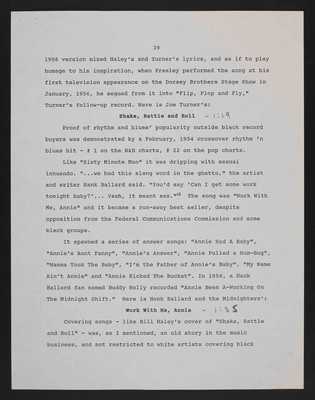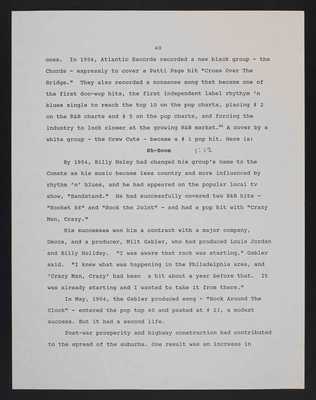Pages
36
36
black music recording and promotion. He owned a taxi company, a night club and a booking agency. Nelson George notes: "A decade before Berry Gordy's ascendence, Robey was a successful black record executive."37 Robey, unsatisfied with Thornton's sales, sent her to Los Angeles to be produced by Johnny Otis, a drummer of Greek descent "who had married a black women and lived in the black milieu."38 Otis claims he re-wrote a portion of the song written by Lieber and Stoller, although a subsequent lawsuit to claim a co-writer's credit was unsuccessful. "They put some stuff in there which black people would find offensive", he said. "They had lyrics about knives and fighting and scars, all negative stereotypes."
Whatever the truth of the story, the song was written for a woman, singing about a man who has outlived his sexual usefulness. A cover was recorded by another R&B group, Freddy Bell and the Bell Boys, and Presley heard them perform it live during his first, unsuccessful Las Vegas appearance in 1956. "We stole it straight from them," Presley's guitarist Scotty Moore said. "He already knew the song, but when we seen those guys do it, he said 'That's a natural'."39 In the studio, Presley said, "Let's do it the way them boys did it."40 Here is Big Mama Thornton's:
Hound Dog - 1:20
Big Joe Turner was born in Kansas City in 1911. He claimed he originated the singing style of blues shouting, and a 1953 Turner hit linked Kansas City jazz with New Orleans rhythm 'n'
37
37
blues. The song also influenced a later 1954 Turner hit, "Shake, Rattle and Roll", which was covered by Bill Haley in a 1954 # 7 pop hit. This song, 'Honey Hush' was # 1 for eight weeks on the R&B charts and # 23 on the pop charts. Here is:
Honey Hush - :49
By 1953, rhythm 'n' blues music was increasingly listened to by white teenagers, and a small army of disc jockeys now played rhythm 'n' blues music - Hunter Hancock in Los Angeles, Zenas "Daddy" Sears in Atlanta, Ken "Jack the Cat" Elliot in New Orleans, and Tom "Big Daddy" Donahue in Washington - to service what Sponsor magazine called the "forgotten 15 million black consumers in America", and by the early '50s, most large Southern cities had black oriented radio stations. But only one R&B song - 1951's "Sixty Minute Man" - had broken into the pop top 20. "Sixty Minute Man" was an anomaly - a song so sexual it could not be sung on the popular television show, "Your Hit Parade." But a 1953 song "Gee" by a group with an avian appellation, the Crows, reached # 2 on the R&B charts and # 14 on the pop charts. It was also the first '50s style doo-wop song to sell a million records. The record's success was due to a white disc jockey who played black music, Los Angeles' Dick "Huggy Boy" Hugg. He broadcast a show, "Harlem Hit Parade" from the front window of a popular record store at the corner of Vernon and Central Avenues in the middle of black Los Angeles, the epi-center, incidentally, of the 1965 riot. "Gee's" success prompted Billboard to write in April, "Teenagers going for Music With a Beat As Industry Reaps A
38
38
Financial Harvest." The article said, "One of the fastest growing segments of the record business is the rhythm 'n' blues field.... More than 700 jocks across the country devote their air time exclusively to rhythm 'n' blues platters....Teenagers are instigating the current trend toward r & b and are largely responsible for keeping its sales mounting...."41 Here is:
Gee - :57
Big Joe Turner's 1953 hit "Honey Hush" was the predicate for his next big hit, "Shake, Rattle and Roll." He had been singing versions of this song during World War II, but writing credit went to Charles Calhoun, a pseudonym for Atlantic Records A&R man Jesse Stone. Stone thought white teenagers would listen to rhythm 'n' blues as long as it had a danceable rhythm. "So I designed a bass-pattern," he said, "and it sort of became indentified with rock 'n' roll."42
The song also has its share of double entendre - "over the hill, way down underneath" and "wearing low dresses, the sun comes shinin' through, girl I can't believe all that mess belongs to you." "Shake, Rattle and Roll" went to # 1 on the R&B charts and # 22 on the pop charts. Bill Haley's cover version went to # 7 on the pop charts, but both sold over one million records, making it the first giant rock 'n' roll hit. Haley's version cleaned up the song; "wearing low dresses" became "Wearing those dresses, you hair done up so nice". Where Turner sang "I believe to my soul you're the devil in nylon hose" Haley sang " I believe you're doin' me wrong and now I know." Elvis Presley's
39
39
1956 version mixed Haley's and Turner's lyrics, and as if to play homage to his inspiration, when Presley performed the song at his first television appearance on the Dorsey Brothers Stage Show in January, 1956, he segued from it into "Flip, Flop and Fly," Turner's follow-up record. Here is Joe Turner's:
Shake, Rattle and Roll - 1:19
Proof of rhythm and blues' popularity outside black record buyers was demonstrated by a February, 1954 crossover rhythm 'n' blues hit - # 1 on the R&B charts, # 22 on the pop charts.
Like "Sixty Minute Man" it was dripping with sexual innuendo. "...we had this slang word in the ghetto," the artist and writer Hank Ballard said. "You'd say 'Can I get some work tonight baby?'... Yeah, it meant sex."43 The song was "Work With Me, Annie" and it became a run-away best seller, despite opposition from the Federal Communications Commission and some black groups.
It spawned a series of answer songs: "Annie Had A Baby", "Annie's Aunt Fanny", "Annie's Answer", "Annie Pulled a Hum-Bug", "Mamma Took The Baby", "I'm the Father of Annie's Baby", "My Name Ain't Annie" and "Annie Kicked The Bucket". In 1956, a Hank Ballard fan named Buddy Holly recorded "Annie Been A-Working On The Midnight Shift." Here is Hank Ballard and the Midnighters':
Work With Me, Annie - 1:35
Covering songs - like Bill Haley's cover of "Shake, Rattle and Roll" - was, as I mentioned, an old story in the music business, and not restricted to white artists covering black
40
40
ones. In 1954, Atlantic Records recorded a new black group - the Chords - expressly to cover a Patti Page hit "Cross Over The Bridge." They also recorded a nonsense song that became one of the first doo-wop hits, the first independent label rhythm 'n' blues single to reach the top 10 on the pop charts, placing # 2 on the R&B charts and # 5 on the pop charts, and forcing the industry to look closer at the growing R&B market.44 A cover by a white group - the Crew Cuts - became a # 1 pop hit. Here is:
Sh-Boom 1:12
By 1954, Billy Haley had changed his group's name to the Comets as his music became less country and more influenced by rhythm 'n' blues, and he had appeared on the popular local tv show, "Bandstand." He had successfully covered two R&B hits - "Rocket 88" and "Rock the Joint" - and had a pop hit with "Crazy Man, Crazy."
His successes won him a contract with a major company, Decca, and a producer, Milt Gabler, who had produced Louis Jordan and Billy Holiday. "I was aware that rock was starting," Gabler said. "I knew what was happening in the Philadelphia area, and 'Crazy Man, Crazy' had been a hit about a year before that. It was already starting and I wanted to take it from there."
In May, 1954, the Gabler produced song - "Rock Around The Clock" - entered the pop top 40 and peaked at # 23, a modest success. But it had a second life.
Post-war prosperity and highway construction had contributed to the spread of the suburbs. One result was an increase in
